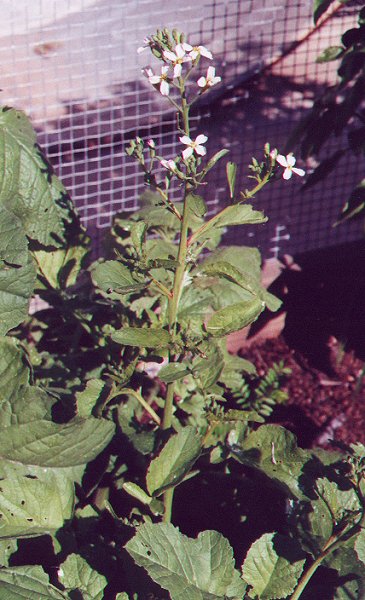Raphanus sativus L.
Radish

Introduced
CC = *
CW = 5
MOC = 5
© DETenaglia
Raphanus sativus L.Radish | |
 |
Introduced CC = * CW = 5 MOC = 5 |
© DETenaglia |
|
Family - Brassicaceae Habit - Annual or biennial forb with thickened, fleshy roots. Stems - Ascending to erect, to 80 cm, sometimes branched, glabrous or sparsely pubescent with simple hairs.
Leaves - Basal and alternate, irregularly pinnately lobed or divided, the lobes larger toward the leaf tip, the margins toothed or lobed. Basal leaves 5-25 cm long, the stem leaves 2-10 cm long, usually hairy.
Inflorescence - Panicles, the lower branches subtended by reduced leaves, the flowers bractless.
Flowers - Sepals erect, narrowly oblong, 8.0-11.0 mm long. Petals unlobed, 15-20 mm long, purple, pink, or rarely nearly white, with dark purple veins.
Fruits - Siliques 3-6 cm long, 5-15 mm wide, corky, segmented into apical and basal portions, the basal portion relatively short, seedless, and stalklike, the apical portion 4 or more times as long as the basal portion, tapering in the apical 1/4-1/2 to a distinct, conical, seedless beak 1-3 cm long in addition to the style, sometimes narrowed between the seeds, the surface smooth or faintly ribbed, at maturity remaining indehiscent, the stalk 0.5-4.0 cm long, indehiscent or eventually breaking between the seeds into 1-seeded segments. Seeds 1-4 per fruit, 2.5-4.0 mm in diameter, globose or nearly ovoid.
Flowering - May - August. Habitat - Widely cultivated and escaped to roadsides, waste ground, and railroads. Origin - Native to Europe. Lookalikes - None. Other info. - This is the species of the common garden radish, widely cultivated for the edible, spicy roots but only uncommonly and sporadically escaping. Many cultivars have been developed, usually to introduce desired characteristics in the roots. A similar plant, R. raphanistrum L., has yellow flowers and an unexpanded root. The two have been known to hybridize, though this has not been observed in Missouri. The fruits of Raphanus are unusual in that the seeds occupy a single vertical rank and are immersed in corky tissue with no locules in the mature fruit. The reduced basal segment usually contains vestiges of the replum. Photographs taken at the Kansas City Zoo, 5-10-00 (DETenaglia); also just south of Fortuna, Humboldt County, CA, 7-14-2014 (SRTurner). |